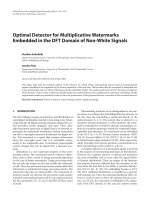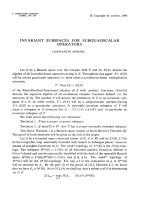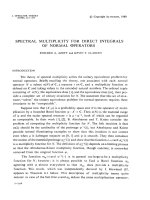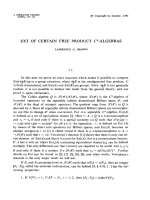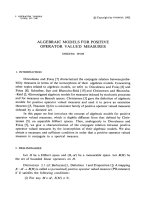Báo cáo toán học: "Cyclic sieving for longest reduced words in the hyperoctahedral group" doc
Bạn đang xem bản rút gọn của tài liệu. Xem và tải ngay bản đầy đủ của tài liệu tại đây (152.34 KB, 12 trang )
Cyclic sieving for longest reduced words
in the hyperoctahedral group
T. Kyle Petersen
Department of Mathematical Sciences
DePaul University, Chicago, IL
Luis Serrano
Department of Mathematics
University of Michigan, Ann Arbor, MI
Submitted: Jun 2, 2009; Accepted: Apr 22, 2010; Published: Apr 30, 2010
Mathematics Subject Classifications: 05E10, 05E15, 05E18
Abstract
We show that the set R(w
0
) of reduced expressions for the longest element in the
hyperoctahedral group exhibits the cyclic sieving phenomenon. More specifically,
R(w
0
) possesses a natural cyclic action given by moving the first letter of a word
to the end, and we show that the orbit structure of this action is encoded by the
generating function for the major index on R(w
0
).
1 Introduction and main result
Suppose we are given a finite set X, a finite cyclic group C = ω acting on X, and a
polynomial X(q) ∈ Z[q] with integer coefficients. Following Reiner, Stanton, and White
[RSW], we say that the triple (X, C, X(q)) exhibits the cyclic sieving phenomenon (CSP)
if for every integer d 0, we have that |X
ω
d
| = X(ζ
d
) where ζ ∈ C is a root of unity of
multiplicitive order |C| and X
ω
d
is the fixed point set of the action of the power ω
d
. In
particular, since the identity element fixes everything in any g r oup action, we have that
|X| = X(1) whenever (X, C, X(q)) exhibits the CSP.
If the triple (X, C, X(q)) exhibits the CSP and ζ is a primitive |C|
th
root of unity, we
can determine the cardinalities of the fixed p oint sets X
1
= X, X
ω
, X
ω
2
, . . . , X
ω
|C|−1
via
the polynomial evaluations X(1), X(ζ), X(ζ
2
), . . . , X(ζ
|C|−1
). These fixed point set sizes
determine the cycle structure of the canonical image of ω in the group of permutations of
X, S
X
. Therefore, to find the cycle structure of the image of any bijection ω : X → X,
it is enough to determine the order of the action of ω on X and find a polynomial X(q)
such that (X, ω, X(q)) exhibits the CSP.
The cyclic sieving phenomenon has been demonstrated in a variety of contexts. The
paper of Reiner, Stanton, and White [RSW] itself includes examples involving noncross-
ing partitions, triangulations of polygons, and cosets of parabolic subgroups of Coxeter
the electronic journal of combinatorics 17 (2010), #R67 1
groups. An example of the CSP with standard Young tableaux is due to Rhoades [Rh]
and will be discussed further in Section 4. Now we turn to the CSP of interest to this
note.
Let w
0
= w
(B
n
)
0
denote the longest element in the type B
n
Coxeter group. Given
generating set S = {s
1
, . . . , s
n
} for B
n
, (s
1
being the “special” reflection), we will write a
reduced expression for w
0
as a word in the subscripts. For example, w
(B
3
)
0
can be written
as
s
1
s
2
s
1
s
3
s
2
s
3
s
1
s
2
s
3
;
we will abbreviate this product by 121 323123. It turns out that if we cyclically permute
these letters, we always get another reduced expression for w
0
. Said another way, s
i
w
0
s
i
=
w
0
for i = 1, . . . , n. The reason for this is that in the standard reflection representation of
the type B
n
Coxeter group, the longest element w
0
is the scalar transformation −1, and
thus commutes with all simple reflections s
i
. The same is not true for longest elements of
other classical types. In type A, we have s
i
w
(A
n
)
0
s
n+1−i
= w
(A
n
)
0
, and for type D,
w
(D
n
)
0
=
s
i
w
(D
n
)
0
s
i
if n even or i > 2,
s
i
w
(D
n
)
0
s
3−i
if n odd and i = 1, 2.
Let R(w
0
) denote the set of reduced expressions for w
0
in type B
n
and let c : R(w
0
) →
R(w
0
) denote the action of placing the first letter of a word at the end. Then the orbit
in w
0
(B
3
) of the word above is:
{121323123 → 213231231 → 1323 12312 → 32312312 1 → 231231213
→ 312312132 → 12312132 3 → 231213231 → 312132312}.
As the length of w
0
is n
2
, we clearly have c
n
2
= 1, and the size of any orbit divides n
2
.
For an example of a smaller orbit, notice that the word 2 13213213 has cyclic or der 3.
For any word w = w
1
. . . w
l
, (e.g., a reduced expression fo r w
0
), a descent of w is
defined to b e a position i in which w
i
> w
i+1
.The major index of w, maj(w), is defined
as the sum of the descent positions. For example, the word w = 121323123 has descents
in positions 2, 4, and 6, so its major index is maj(w) = 2 + 4 + 6 = 12. L et f
n
(q) denote
the generating function for this statistic on words in R(w
0
):
f
n
(q) =
w∈R(w
0
)
q
maj(w)
.
The following is our main result.
Theorem 1. The triple (R(w
0
), c, X(q)) exhibits the cyclic sieving phenomenon, where
X(q) = q
−n
(
n
2
)
f
n
(q).
the electronic journal of combinatorics 17 (2010), #R67 2
For example, let us consider the case n = 3. We have
X(q) = q
−9
w∈w
0
(B
3
)
q
maj(w)
= 1 + q
2
+ 2q
3
+ 2q
4
+ 2q
5
+ 4q
6
+ 3q
7
+ 4q
8
+ 4q
9
+ 4q
10
+ 3q
11
+ 4q
12
+ 2q
13
+ 2q
14
+ 2q
15
+ q
16
+ q
18
.
Let ζ = e
2πi
9
. Then we compute:
X(1) = 42 X(ζ
3
) = 6 X(ζ
6
) = 6
X(ζ) = 0 X(ζ
4
) = 0 X(ζ
7
) = 0
X(ζ
2
) = 0 X(ζ
5
) = 0 X(ζ
8
) = 0
Thus, the 42 reduced expressions f or w
(B
3
)
0
split into two orbits of size three (the orbits of
123123123 and 1321321 32) and four orbits of size nine.
To prove Theorem 1 we rely on a pair of remarkable bijections due to Haiman [H1, H2],
and a recent (and deep) result of Rhoades [Rh, Thm 3.9]. The composition of Haiman’s
bijections relates R(w
0
) with the set SY T(n
n
) of standard Young tableaux of square
shape. Rhoades’ result is that there is a CSP f or SY T(n
n
) with respect to the action of
promotion (defined in Section 2). In this note our main goal is to show that Haiman’s
bijections carry the orbit structure of promotion on SY T(n
n
) to the orbit structure of c
on R(w
0
).
We conclude this section by r emarking that this result was first stated by Rhoades
[Rh, Thm 8.1]. While our proof follows the same structure as his, we feel that this article
fills in some nontrivial gaps in his argument. Moreover, the fact that the polynomial
X(q) can be expressed as the generating function for the major index on R(w
0
) is new.
We thank Brendon Rhoades for encouraging us to write this note. Thanks also to Kevin
Dilks, John Stembridge, and Alex Yong for fruitful discussions on this and related topics,
and t o Sergey Fomin for comments on the manuscript.
2 Promotion on standard Young tableaux
For λ a partition, let SY T(λ) denote the set of standard Young tableaux of shape λ.
If λ is a strict partition, i.e., with no equal parts, then let SY T
′
(λ) denote the set of
standard Young tableaux of shifted shape λ. We now describe the action of jeu de taquin
promotion, first defined by Sch¨utzenberger [Sch].
We will consider promotion as a permutation of tableaux of a fixed shape (resp. shifted
shape), p : SY T(λ) → SY T(λ) (resp. p : SY T
′
(λ) → SY T
′
(λ)). Given a λ-tableau T
with λ ⊢ n, we form p(T ) with the following algorithm. (We denote the entry in row a,
column b of a tableau T , by T
a,b
.)
1. Remove the entry 1 in the upper left corner and decrease every other entry by 1.
The empty box is initialized in position (a, b) = (1, 1).
the electronic journal of combinatorics 17 (2010), #R67 3
2. Perform jeu de t aquin:
(a) If there is no box to the right of the empty box and no box below t he empty
box, then go to 3).
(b) If there is a box to the right o r b elow the empty box, then swap the empty box
with the box containing the smaller entry, i.e., p(T )
a,b
:= min{T
a,b+1
, T
a+1,b
}.
Set (a, b) := (a
′
, b
′
), where (a
′
, b
′
) are the coordinates of box swapped, and go
to 2a).
3. Fill the empty box with n.
Here is an example:
T =
1 2 4 8
3 6 7
5
→
1 3 6 7
2 5 8
4
= p(T ).
As a permutation, promotion naturally splits SY T(λ) into disjoint orbits. For a
general shap e λ there seems to be no obvious pattern to the sizes of the orbits. However,
for certain shapes, notably Haiman’s “generalized staircases” more can be said [H2] (see
also Edelman and Greene [EG, Cor. 7.23]). In particular, rectangles fall into this category,
with the following result.
Theorem 2 ([H2], Theorem 4.4). If λ ⊢ N = bn is a rectangle, then p
N
(T ) = T for all
T ∈ SY T(λ).
Thus for n × n square shapes λ, p
n
2
= 1 and the size of every orbit divides n
2
. With
n = 3, here is an orbit of size 3:
1 2 5
3 6 8
4 7 9
→
1 4 7
2 5 8
3 6 9
→
1 3 6
2 4 7
5 8 9
→ · · · . (1)
There are 42 standard Young tableaux of shape (3, 3, 3), and there are 42 reduced
expressions in the set w
0
(B
3
). Stanley first conjectured that R(w
0
) and SY T(n
n
) are
equinumerous, and Proctor suggested that rather than SY T(n
n
), a more direct corre-
spondence might be given with SY T
′
(2n − 1, 2n − 3, . . . , 1), that is, with shifted standard
tableaux of “doubled staircase” shape. (That the squares and doubled staircases are
equinumerous follows easily from hook length formulas.)
Haiman answers Proctor’s conjecture in such a way that the structure of promotion
on doubled staircases corresponds precisely to cyclic permutation of words in R(w
0
) [H2,
Theorem 5.12]. Moreover, in [H1, Proposition 8.11], he gives a bijection between standard
Young tableaux of square shape and those of doubled staircase shape that (as we will show)
commutes with promotion.
As an example, his bijection carries the orbit in (1) to this shifted orbit:
1 2 4 5 8
3 6 9
7
→
1 2 3 4 7
5 6 8
9
→
1 2 3 6 9
4 5 7
8
→ · · · .
Both of these orbits of tableaux correspond to the orbit of the reduced word 132132132.
the electronic journal of combinatorics 17 (2010), #R67 4
3 Haiman’s bijections
We first describe the bijection between reduced expressions and shifted standard tableaux
of doubled staircase shape. This bijection is described in Section 5 of [H2].
Let T be in SY T
′
(2n − 1, 2n − 3, . . . , 1). Notice the largest entry in T , (i.e., n
2
),
occupies one o f the outer corners. Let r(T ) denote the row containing this largest entry,
numbering the rows from the bottom up. The promotion sequence of T is defined to be
Φ(T ) = r
1
· · · r
n
2
, where r
i
= r(p
i
(T )). Using the example above of
T =
1 2 4 5 8
3 6 9
7
,
we see r(T ) = 2, r(p(T )) = 1, r(p
2
(T )) = 3, and since p
3
(T ) = T , we have
Φ(T ) = 132132 132.
Haiman’s result is the following.
Theorem 3 ([H2], Theorem 5.12). The map T → Φ(T ) is a bijection SY T
′
(2n − 1, 2n −
3, . . . , 1) → R(w
0
).
By construction, then, we have
Φ(p(T )) = c(Φ(T )),
i.e., Φ is an orbit- preserving bijection
(SY T
′
(2n − 1, 2n − 3, . . . , 1), p) ←→ (R(w
0
), c).
Next, we will describe the bijection
H : SY T(n
n
) → SY T
′
(2n − 1, 2n − 3, . . . , 1)
between squares and doubled staircases. Though not obvious from the definition below,
we will demonstrate that H commutes with promotion.
We assume the reader is f amiliar with the Robinson-Schensted-Knuth insertion algo-
rithm (RSK). (See [Sta, Section 7.11], for example.) This is a map between words w and
pairs of tableaux (P, Q) = (P (w), Q(w)). We say P is the insertion tableau and Q is the
recording tableau.
There is a similar correspondence between words w and pairs of shifted tableaux
(P
′
, Q
′
) = (P
′
(w), Q
′
(w)) called shifted mixed insertion due to Haiman [H1]. (See also
Sagan [Sa] and Worley [W].) Serrano defined a semistandard generalization of shifted
mixed insertion in [Ser]. Throughout this paper we refer to semistandard shifted mixed
insertion simply as mixed insertion. Details can be found in [Ser, Section 1.1].
Theorem 4 ([Ser] Theorem 2.26). Let w be a word. If we view Q(w) as a skew shifted
standard Young tableau and apply jeu de taquin to obtain a standard shifted Young tableau,
the result is Q
′
(w) (independent of any choices in applying jeu de taquin).
the electronic journal of combinatorics 17 (2010), #R67 5
For example, if w = 332 132121, then
(P, Q) =
1 1 1
2 2 2
3 3 3
,
1 2 5
3 6 8
4 7 9
,
(P
′
, Q
′
) =
1 1 1 2
′
3
′
2 2 3
′
3
,
1 2 4 5 8
3 6 9
7
.
Performing jeu de taquin we see:
1 2 5
3 6 8
4 7 9
→
1 2 5
3 4 6 8
7 9
→
1 2 5 8
3 4 6
7 9
→
1 2 4 5 8
3 6 9
7
.
Haiman’s bijection is precisely H(Q) = Q
′
. That is, given a standard square tableau
Q, we embed it in a shifted shape and a pply jeu de taquin to create a standard shifted
tableau. That this is indeed a bijection follows from Theorem 4, but is originally found
in [H1, Proposition 8.11].
Remark 5. Haiman’s bijection applies more generally between rectangles and “shifted
trapezoids”, i.e., for m n, we have H : SY T(n
m
) → SY T
′
(n+ m−1, n+m−3, . . . , n−
m + 1). All the results presented here extend to this generality, with similar proofs. We
restict to squares and doubled staircases for clarity of exposition.
We will now fix the t ableaux P and P
′
to ensure that the insertion word w has
particularly nice properties. We will use the following lemma.
Lemma 6 ([Ser ], Proposition 1.8). Fix a word w. Let P = P(w) be the RSK insertion
tableau and let P
′
= P
′
(w) be the mixed insertion tableau. Then the set of words that
mixed insert into P
′
is contained in the set of words that RSK insert into P .
Now we apply Lemma 6 to the word
w = n · · · n
n
· · · 2 · · · 2
n
1 · · · 1
n
.
If we use RSK insertion, we find P is an n × n square tableau with all 1s in row first
row, all 2s in the second row, and so on. With such a choice of P it is not difficult to show
that any other word u inserting to P has the property that for all indices j and all initial
subwords u
1
· · · u
i
, there are at least as many letters (j + 1 ) as letters j. Such words are
sometimes called (reverse) lattice words or (reverse) Yamanouchi words. Notice also that
any such u has n copies of each letter i, i = 1, . . . , n. We call the words inserting to this
choice of P square words.
the electronic journal of combinatorics 17 (2010), #R67 6
On the other hand, if we use mixed insertion on w, we find P
′
as follows (with n = 4):
1 1 1 1 2
′
3
′
4
′
2 2 2 3
′
4
′
3 3 4
′
4
.
In general, on the “shifted half” of the tableau we see all 1s in the first row, all 2s in the
second row, and so on. In the “straight half” we see only prime numbers, with 2
′
on the
first diagonal, 3
′
on the second diagona l, and so on. Lemma 6 tells us that every u that
mixed inserts to P
′
is a square word. But since the sets of recording tableaux for P and
for P
′
are equinumerous, we see that the set of words mixed inserting to P
′
is precisely
the set of all square words.
Remark 7. Yamanouchi words give a bijection with standard Young tableaux that circum-
vents insertion completely. In reading the word from left to right, if w
i
= j, we put letter
i in the leftmost unoccupied position of row n + 1 − j. (See [Sta, Proposition 7.10.3(d)].)
We will now characterize promotion in terms of operators on insertion words. First,
some lemmas.
For a tableau T (shifted or not) let ∆T denote the result of all but step (3) of pro-
motion. That is, we delete the smallest entry and perform jeu de taquin, but we do not
fill in the empty box. The following lemma says that, in both the shifted and unshifted
cases, this can be expressed very simply in t erms of our insertion word. The first part of
the lemma is a direct application of the theory of jeu de taquin (see, e.g., [Sta, A1.2]);
the second part is [Ser, Lemma 3.9].
Lemma 8. For a word w = w
1
w
2
· · · w
l
, let w = w
2
· · · w
l
. Then we have
Q( w) = ∆Q(w),
and
Q
′
( w) = ∆Q
′
(w).
The operator e
j
acting on words w = w
1
· · · w
l
is defined in the following way. Consider
the subword of w formed only by the letters j and j+1. Consider every j+1 as an opening
bracket and every j as a closing bracket, and pair them up accordingly. The remaining
word is of the form j
r
(j + 1)
s
. The operator e
j
leaves all of w invariant, except for this
subword, which it changes to j
r−1
(j + 1)
s+1
. (This operator is widely used in the theory
of crystal graphs.)
As an example, we calculate e
2
(w) for the word w = 3121221332. The subword formed
from the letters 3 and 2 is
3 · 2 · 22 · 332,
which corresponds to the bracket sequence ()))((). Removing paired brackets, one obtains
))(, corresponding to the subword
· · · · 22 · 3 · ·.
the electronic journal of combinatorics 17 (2010), #R67 7
We change the last 2 to a 3 and keep the rest of the word unchanged, obtaining e
2
(w) =
3121231332.
The following lemma shows that this operator leaves the r ecording tableau unchanged.
The unshifted case is found in work of L ascoux, Leclerc, and Thibon [LLT]; the shifted
case follows from t he unshifted case, and the fact that the mixed recording tableau of a
word is uniquely determined by its RSK recording tableau ([Ser, Theorem 2.26]).
Lemma 9 ([LLT] Theorem 5.5.1). Recording tableaux are invariant under the operators
e
i
. That is,
Q(e
i
(w)) = Q(w) ,
and
Q
′
(e
i
(w)) = Q
′
(w).
Let e = e
1
· · · e
n−1
denote the composite operator given by applying first e
n−1
, then
e
n−2
and so on. It is clear that if w = w
1
· · · w
n
2
is a square word, then e( w) 1 is again a
square word.
Theorem 10. Let w = w
1
· · · w
n
2
be a square word. Then,
p(Q(w)) = Q(e( w)1),
and
p(Q
′
(w)) = Q
′
(e( w)1).
In other words, Haiman’s bijection commutes with promotion:
p(H(Q)) = H(p(Q)).
Proof. By Lemma 8, we see that Q( w) is only one box away from p(Q(w)). Further,
repeated application of Lemma 9 shows that
Q( w) = Q(e
n−1
( w)) = Q(e
n−2
(e
n−1
( w))) = · · · = Q(e( w)).
The same lemmas apply show Q
′
(e( w)) is one box away from p(Q
′
(w)).
All that remains is to check tha t the box added by inserting 1 into P (e( w)) (resp.
P
′
(e( w))) is in t he correct position. But this follows from the observation that e( w)1 is
a square word, and square words insert (resp. mixed insert) to squares (resp. doubled
staircases).
4 Rhoades’ result
Rhoades [Rh] proved a n instance of the CSP related to the action of pro motio n on rect-
angular tableaux. His result is quite deep, employing Ka hzdan-Lusztig cellular represen-
tation theory in its proof.
the electronic journal of combinatorics 17 (2010), #R67 8
Recall that for any partition λ ⊢ n, we have that the standard tableaux of shape λ
are enumerated by the Frame-Robinson-Thrall hook length formula:
f
λ
= |SY T(λ)| =
n!
(i,j)∈λ
h
ij
,
where the product is over the boxes (i, j) in λ and h
ij
is the hook length at the box (i, j),
i.e., the number o f boxes directly east or south of the box (i, j) in λ, counting itself exactly
once. To obtain the polynomial used for cyclic sieving, we replace the hook length formula
with a natural q-analogue. First, recall that for any n ∈ N, [n]
q
:= 1 + q + · · · + q
n−1
and
[n]
q
! := [n]
q
[n − 1]
q
· · · [1]
q
.
Theorem 11 ([Rh], Theorem 3.9). Let λ ⊢ N be a rectangular shape and let X = SY T(λ).
Let C := Z/NZ act on X via promotion. Then, the triple (X, C, X(q)) exhibits the cyclic
sieving phenomenon, where
X(q) =
[N]
q
!
Π
(i,j)∈λ
[h
ij
]
q
is the q-analogue of the hook length formula.
Now thanks to Theorem 10 we know that H preserves orbits of promotion, and as a
consequence we see the CSP for doubled staircases.
Corollary 12. Let X = SY T
′
(2n − 1, 2n − 3, . . . , 1), and let C := Z/n
2
Z act on X via
promotion. Then the triple (X, C, X(q)) exhibits the cyclic sieving phenomenon, where
X(q) =
[n
2
]
q
!
[n]
n
q
n−1
i=1
([i]
q
· [2n − i]
q
)
i
is the q-analogue of the hook length formula for an n × n square Young diagram.
Because of Theorem 3 the set R(w
0
) also exhibits the CSP.
Corollary 13 ([Rh], Theorem 8.1). Let X = R(w
0
) and let X(q) as in Corollary 12. Let
C := Z/n
2
Z act on X by cyclic rotation of words. Then the triple (X, C, X(q)) exhibits
the cyclic sieving phenomenon.
Corollary 13 is the CSP for R(w
0
) as stated by Rhoades. This is nearly our main
result (Theorem 1), but for the definition of X(q).
In spirit, for a CSP (X, C, X(q)), the polynomial X(q) should be some q-enumerator
for the set X. That is, it should be expressible as
X(q) =
x∈X
q
s(x)
,
where s is an intrinsically defined statistic for the elements of X. Indeed, nearly all known
instances of the cyclic sieving phenomenon have t his property. For example, it is known
the electronic journal of combinatorics 17 (2010), #R67 9
([Sta, Cor 7.21.5 ]) t hat the q-analogue of the hook-length formula can be expressed as
follows:
f
λ
(q) = q
−κ(λ)
T ∈SY T (λ)
q
maj(T )
, (2)
where κ(λ
1
, . . . , λ
l
) =
1il
(i − 1)λ
i
and for a tableau T , maj(T ) is the sum of all i such
that i appears in a row above i + 1. Thus X(q) in Theorem 11 can be described in terms
a statistic on Young tableaux.
With this point of view, Corollaries 12 and 13 are aesthetically unsatisfying. Section
5 is given to showing that X(q) can be defined as the generating function for the major
index on words in R(w
0
). It would be interesting to find a combinatorial description for
X(q) in terms of a statistic on SY T
′
(2n − 1, 2n − 3, . . . , 1) as well, though we have no
such description at present.
5 Combinatorial description of X(q)
As stated in the introduction, we will show that
X(q) = q
−n
(
n
2
)
w∈R(w
0
)
q
maj(w)
.
If we specialize (2) to square shapes, we see that κ(n
n
) = n
n
2
and
X(q) = q
−n
(
n
2
)
T ∈SY T (n
n
)
q
maj(T )
.
Thus it suffices to exhibit a bijection between square ta bleaux and words in R( w
0
) that
preserves major index. In fact, the composition Ψ := ΦH has a stronger feature.
Define the cyclic descent set of a word w = w
1
· · · w
l
to be the set
D(w) = {i : w
i
> w
i+1
} (mod l)
That is, we have descents in the usual way, but also a descent in position 0 if w
l
> w
1
.
Then maj(w) =
i∈D(w)
i. For example with w = 132132132, D(w) = {0, 2, 3, 5, 6, 8} and
maj(w) = 0 + 2 + 3 + 5 + 6 + 8 = 24.
Similarly, we f ollow [Rh] in defining the cyclic descent set of a square (in general,
rectangular) Young tableau. For T in SY T(n
n
), define D(T ) to be the set of all i such
that i appears in a row above i + 1 , along with 0 if n
2
− 1 is above n
2
in p(T ). Major
index is maj(T ) =
i∈D(T )
i. We will see that Ψ preserves cyclic descent sets, and hence,
major index. Using our earlier example of w = 132132132, one can check that
T = Ψ
−1
(w) =
1 2 5
3 6 8
4 7 9
has D(T ) = D(w), and so maj(T ) = maj(w).
the electronic journal of combinatorics 17 (2010), #R67 10
Lemma 14. Let T ∈ SY T(n
n
), and let w = Ψ(T ) in R(w
0
). Then D(T ) = D(w).
Proof. First, we observe that both types of descent sets shift cyclically under their re-
spective a ctions:
D(p(T )) = {i − 1 (mod n
2
) : i ∈ D(T )},
and
D(c(w)) = {i − 1 (mod n
2
) : i ∈ D(w)}.
For words under cyclic rotation, this is obvious. For tableaux under promotion, this is a
lemma of Rhoades [Rh, Lemma 3.3].
Because of this cyclic shifting, we see that i ∈ D(T ) if and only if 0 ∈ D(p
i
(T )).
Thus, it suffices t o show that 0 ∈ D(T ) if and only if 0 ∈ D(w). (Actually, it is easier to
determine if n
2
− 1 is a descent.)
Let S = Φ
−1
(w) be the shifted doubled staircase tableau corresponding to w. We have
n
2
− 1 ∈ D(w) if a nd only if n
2
is in a higher row in p
−1
(S) than in S. But since n
2
occupies the same place in p
−1
(S) as n
2
− 1 occupies in S, t his is to say n
2
− 1 is above
n
2
in S. On the other hand, n
2
− 1 ∈ D(T ) if and only if n
2
− 1 is above n
2
in T . It is
straightforward to check that since S is obtained from T by jeu de taquin into the upper
corner, the relative heights of n
2
and n
2
−1 (i.e., whether n
2
is below or not) are the same
in S as in T . This completes the proof.
This lemma yields the desired result for X(q).
Theorem 15. The q-analogue of the hook length formula for an n × n square Young
diagram is, up to a shift, the major index generating function for reduced expressions of
the longest element in B
n
:
w∈R(w
0
)
q
maj(w)
= q
n
(
n
2
)
·
[n
2
]
q
!
[n]
n
q
n−1
i=1
([i]
q
· [2n − i]
q
)
i
.
Theorem 15, along with Corollar y 13, complete the proof of our main result, Theorem
1. Because this result can be stated purely in terms of the set R(w
0
) and a natural statistic
on this set, it would be interesting to obtain a self-contained proof, i.e., one that does not
appeal to Haiman’s or Rhoades’ work. Why must a result about cyclic rotation of words
rely on promotion of Yo ung tableaux?
References
[EG] P. Edelman and C. Greene: Balanced tableaux, Adv. in Math. 63 (1987),
42–99.
[H1] M. Haiman: On mixed insertion, symmetry, and shifted Young tableaux, J.
Combin. Theory Ser. A 50 (1989), no. 2, 19 6–225.
[H2] M. Haiman: Dual equivalence with applications, including a conjecture of Proc-
tor, Discrete Math. 99 (1992), 79–113.
the electronic journal of combinatorics 17 (2010), #R67 11
[LLT] A. Lascoux, B. Leclerc, and J. -Y. Thibon, The plactic monoid, in “M. Lothaire,
Algebraic combinatorics on words”, Cambridge University Press, Cambridge,
2002 (Chapter 6).
[RSW] V. Reiner, D. Stanton and D. White: The cyclic sieving phenomenon, J.
Combin. Theory Ser. A 108 (2004), no. 1, 17–50.
[Rh] B. Rhoades: Cyclic sieving, promotion, and representation theory, Ph.D. the-
sis, University of Minnesota, 2008 .
[Sa] B. Sagan: Shifted tableaux, Schur Q-functions, and a conjecture of R. P.
Stanley, J. Combin. Theory Ser. A 45 (1987), 62–103.
[Ser] L. Serrano: The shifted plactic monoid, arXiv: 0811.205 7.
[Sch] M. P. Sch
¨
utzenberger: Promotion des morphismes d’ensembles ordonn´es,
Discrete Mathematics 2, (197 2), 73–94.
[Sta] R. Stanley: Enumerative Combinatorics Vol 2, Cambridge University Press,
Cambridge, UK, 1999.
[W] D. R. Worley: A theory of shifted Young tableaux, Ph.D. t hesis, MIT, 1984;
available at />the electronic journal of combinatorics 17 (2010), #R67 12



